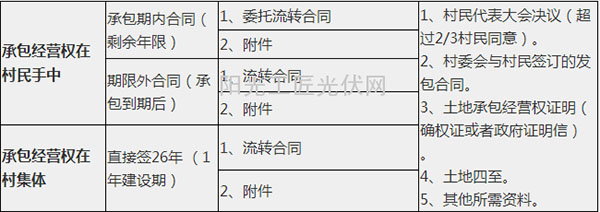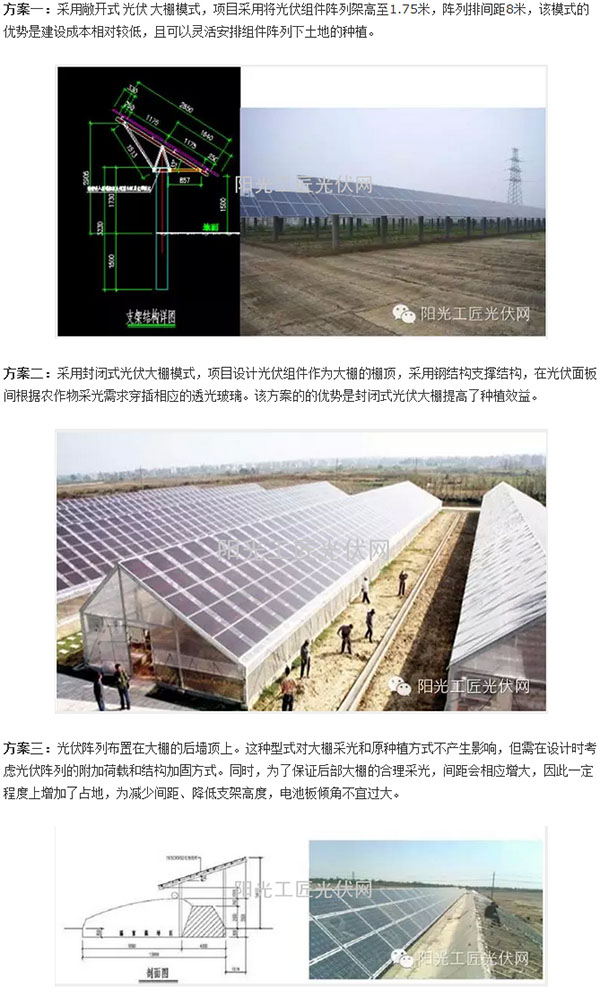Foreword: With the gradual shift of the photovoltaic market to the domestic market, various power generation enterprises have rushed around, and land resources have gradually become scarce and expensive. What is the next step in the development of "photovoltaic +"? Unused land such as barren hills, barren slopes, and tidal flats is running out. Photovoltaic projects built on construction land are a bit extravagant. Renting a company's roof is a solution, but who can guarantee that the roof will not change in 25 years? According to the State Council Office for Poverty Alleviation and the National Energy Administration jointly issued the Notice on Printing and Photovoltaic Poverty Alleviation Project Work Plan and the Joint Announcement of the General Office of the CPC Central Committee and the General Office of the State Council, “Regarding the Orderly Transfer of Rural Land Management Rights, Developing Moderate Scale Operation of Agriculture†The “Opinions†and other series of support policies for agriculture were introduced, and “photovoltaic + agriculture†has already revealed its shape. What is a photovoltaic power plant? Classification of photovoltaic power plants? At present, what kind of predicament faced by photovoltaic companies? Xiao Bian does not give any details, and only put forward his own opinions on the start-up, construction and operation of photovoltaic agriculture projects. Photovoltaic greenhouses, ie, agricultural projects combining facility agriculture and photovoltaic power generation, are engaged in agricultural production activities under sheds. Photovoltaic power generation is used at the roof of the shed. This will not only change the use of land, but also increase the overall utilization rate of land, so that the economic benefits per acre of land will increase. High, improve the local energy structure and improve air quality. The following points need to be noted during the development of photovoltaic agricultural projects: First, to comply with relevant national policies 1. The national high-voltage line of 1.8 billion mu of basic farmland must not be touched and must adhere to the basic principle of farmland agricultural use. At the Central Rural Work Conference held on December 23, 2013, it was proposed to ensure food security and stick to the red line of 1.8 billion mu of arable land. This requires us to take agricultural production as the starting point for our work. If we do not take this issue seriously, I am afraid that we will assume legal responsibility. At present, China is faced with a situation in which food demand and food production are inequality. The main reasons for this phenomenon are the extensive use of arable land. Inefficient, high-cost production methods based on households are no longer able to meet the growing material needs of the people. It is precisely because of this that the State has promulgated the "Opinions on Leading Rural Land Management Rights to Circulate and Develop Moderately Scaled Agricultural Operations" to encourage large-scale operations. As a modern, large-scale and intelligent agricultural development model, the photovoltaic agricultural project integrates and centralizes land, builds photovoltaic greenhouses, improves crop growth environment, and integrates management of planting, irrigation, harvesting, transportation, etc., resulting in significant savings. The operating cost has increased the production efficiency. The development of photovoltaic agriculture sheds will surely thrive in the future. 2. To comply with the overall requirements of the Ministry of Land and Resources on facility agriculture According to the spirit of the directive of No. 127 Document of the Ministry of Land and Resources, all localities should guide the reasonable construction of facilities. All localities should actively guide the development of facility agriculture and the development of large-scale grain production on the premise of protecting cultivated land and rationally using land according to the agricultural development plan and overall land use planning. . Facility construction should make full use of unutilized land such as barren hills and slopes and mudflats and inefficient land use, and it should not occupy or occupy a small amount of cultivated land. If it is really necessary to occupy arable land, it should occupy as much as possible bad quality arable land to avoid indiscriminate use of high-quality arable land. At the same time, through engineering techniques such as soil stripping and utilization of the tillage layer, etc., measures should be taken to minimize damage to the cultivated land. In addition, the document also made further clarification on the definition of agricultural land for facilities. High-standard photovoltaic greenhouses must be designed and constructed. 3. Cultivated land occupation tax According to the Provisional Regulations of the People’s Republic of China on Farmland Occupation Tax that came into effect on January 1, 2008 (1) The area where per capita arable land does not exceed 1 mu, 8-40 yuan/m2; (2) The area where the per capita arable land does not exceed 2 mu, 6-30 yuan/m2; (3) The area of ​​2-3 mu per capita arable land, 5-25 yuan/m2 The Ministry of Finance and the State Administration of Taxation subsequently formulated the "Detailed Rules for the Implementation of the Provisional Regulations on Cultivated Land Acquisition Tax of the People's Republic of China" to clarify the amount of tax. Since the policies adopted in each locality are different, the actual taxation standards are also different, and the specific taxation amount It is advisable to consult the local tax bureau so that you do not lose out. Taking the Hebei region (with a relatively modest tax collection) as an example, a 20-megawatt photovoltaic agricultural project will be built, initially calculated at 400 acres, and an annual farmland occupation tax of about 6 million will be required. It can be seen that the farmland occupation tax is still a small investment cost, so it must be taken seriously. 4, subsidy policy Xiao Bian simply combed out the subsidy policy issued by the state, because local policies are not the same, the following points are for reference only: (1) Subsidy for BIPV: 7.5 yuan/W (2) Agricultural clean energy subsidies: The upper limit is 10 yuan/W (current policy definition is not clear) (3) Benchmark pricing standards: 0.9 yuan/kWh in Category I, 0.95/kWh in Category II, and 1 yuan/kWh in Category III (National Energy Administration's latest policy on solar photovoltaic greenhouses in 2014: installed capacity is less than 20MW, grid access voltage The level does not exceed 35KV and the generated power can be absorbed in the access network transformer station area. The subsidy policy can be implemented according to the local photovoltaic power plant benchmark price.) (4) Local financial subsidies: 1000-8000 yuan/mu (5) Pilot construction of modern agricultural park: 10 million - 20 million (specific allowances are related to the size of local and parks) (6) Vegetable Basket Project Subsidy: 4,000 yuan per shed (different local policies) Second, "winning light" issues The great leader Chairman Mao said: "All things grow by the sun." Without sunlight, plants cannot carry out photosynthesis and they cannot survive. Light affects not only the life of plants but also the distribution of plants. Some plants like strong light such as: pine, cypress, fir, willow, corn, etc.; some plants like low light such as: Adenophora, Panax, Nanxing, Pinellia, ginseng and other Xiyin herbs, mushrooms and other fungi. Photovoltaic power generation principle is the process by which photovoltaic panels are exposed to sunlight and convert light energy into electrical energy. Since both plant growth and photovoltaic power generation are inseparable from sunlight, it is necessary to deal with the distribution of light, and to ensure the normal power generation of solar panels under the premise of sufficient sunlight for plant growth. Third, the problem of land circulation The peasants are a noble profession. Uncle Benshan said: “Not the peasants in the world have worked so hard, have you eaten? Didn't the peasants in the world work hard and wear them? We didn't eat and wear anything but we are stinking?†For heaven, land is the last spiritual home for peasants, and peasants without land have no sense of belonging and security. As an outside investor, the enterprise must be based on the principle of fairness, reasonableness, and mutual benefit, so that farmers can feel that after the transfer of land, they will have greater income and more prosperity than before. Many companies have experienced similar situations, procedures have been completed, the quotas have also been obtained, because the land can not be implemented, construction workers can not enter the site to start, eventually leading to project abortion. Therefore, in the early stage of the project, we must first implement the land, power grid and other conditions well, and the preliminary work should be done in a solid manner. The handling of the later procedures will be a matter of course. The period of land circulation must meet the 25-year operation period, which requires us to understand whether the contractor’s remaining lifespan meets this requirement. The contractual residual period of most of the contractors I meet is less than 25 years (the contract period is a total of 30 years. This requires that we also sign a supplementary agreement with the contracting party (generally the village committee). In order to comply with the regulation of land circulation, it must be done under the guidance of professional lawyers. Fourth, photovoltaic agricultural greenhouse design Traditional stent form: V. Project Operation and Maintenance After the completion of the photovoltaic agricultural project, what kind of photovoltaic greenhouse? How kind? How to manage operations? Where are the profit points? Will there be a loss? These questions can't give clear answers to the approval department and the company's top management. Most project developers tend to be in the direction of photovoltaics, and the number of talents who truly understand both photovoltaics and agriculture is almost zero. This problem poses hidden problems for later project construction and operation and investment returns. In the feasibility study phase of the project, it is necessary to combine the regional advantages of the region in which it is located to find the point where its own project meets the local industrial characteristics. The key point is to integrate the farming, aquaculture, green recycling, tourism and tourism with local characteristics. Get out of a characteristic sustainable development road. Loose Leaf Tea Infuser,Loose Tea Infuser,Cute Tea Infuser,Tea Ball Infuser YANGJIANG VOSSEN INDUSTRY AND TRADE CO.,LTD , https://www.cnvossen.com
